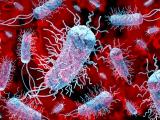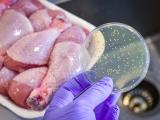Apr 26, 2002 (CIDRAP News) – Salmonella contamination of raw meat and poultry has dropped substantially since the inspection system known as Pathogen Reduction/Hazard Analysis and Critical Control Points (PR/HACCP) debuted in 1998, according to the US Department of Agriculture (USDA).
The agency said the prevalence of Salmonella on all raw meat and poultry products it inspects has declined, in some cases by half or more. However, Salmonella is still fairly common on some products. For example, it was found in about a quarter of ground turkey samples and a fifth of ground chicken samples in 2001.
"This data shows Salmonella prevalence levels well below the product baselines set prior to HACCP," said Agriculture Secretary Ann M. Veneman in a statement issued Apr 18. "This indicates that HACCP has contributed to a reduction in the prevalence of Salmonella in the nation's meat and poultry products."
The USDA followed up its Salmonella report this week by announcing plans for increased efforts to ensure that meat and poultry plants take specific steps to control Salmonella and Escherichia coli O157:H7. In addition, the agency announced it will hold a public scientific symposium on reduction of foodborne pathogens May 6 and 7 in Washington, DC.
In the Salmonella report, USDA presented annual inspection findings for 1998 through 2001 and aggregate data for the 4-year period. "Combined test results for establishments of all sizes show lower Salmonella prevalence in 1998-2001 than in baseline studies," the statement said. Salmonella prevalence in broiler chickens dropped from 20.0% at baseline to 10.7% for 1998 through 2001. The reductions for other products were as follows: market hogs, 8.7% to 5.4%; cows and bulls, 2.7% to 2.2%; steers and heifers, 1.0% to 0.4%; ground beef, 7.5% to 3.4%; ground chicken, 44.6% to 15.7%; and ground turkey, 49.9% to 29.2%.
Trends varied for the different products. Salmonella in ground beef declined steadily through the 4 years, but broiler chickens fluctuated from 10.8% in 1998 to 9.1% in 2000 and 11.9% in 2001. The figures for ground turkey dropped each year until 2001, when they increased slightly. The numbers for ground chicken bounced from 16.2% in 1999 to 13.8% in 2000 and 19.5% in 2001.
"Despite the minor fluctuations, Salmonella prevalences, in all classes of products, have decreased to levels below the baseline prevalence estimates determined prior to HACCP," USDA said.
The agency said the decreasing prevalence of Salmonella correlates with last week's report from the Centers for Disease Control and Prevention (CDC) of declining rates of salmonellosis and other food-related illnesses. The CDC said the incidence of seven common foodborne bacterial diseases dropped 23% between 1996 and 2001, partly because of the HACCP program. In the CDC's FoodNet surveillance program, Salmonella led the list of foodborne pathogens in 2001, causing 15.1 illness cases per 100,000 people.
The prevalence of Salmonella varied somewhat among plants of different sizes. For most products, large plants tended to have less Salmonella than smaller ones, though the opposite was true for ground beef. Over the 4 years, very small broiler plants had substantially more Salmonella than small and large ones (34.7% versus 13.7% and 9.2%, respectively). "Although there are very few small broiler establishments, CY [calendar year] 2001 testing suggests that, as a group, they are having difficulty meeting the performance standard," the report says.
HACCP is a science-based inspection system under which plants must develop a plan to prevent hazards and reduce pathogens in their products. The system took effect for large plants in January 1998, for small plants in January 1999, and for very small plants in January 2000. The meat and poultry samples inspected by the USDA are collected from plants chosen at random.
USDA said that most of the sets of samples tested over the 4 years met the agency's Salmonella performance standards, which are based on nationwide averages determined in the agency's pre-HACCP studies. For all sizes of plants over the 4 years, compliance with the Salmonella standard was 90.8% for broilers, 82.9% for market hogs, 83.7% for cows and bulls, 96.8% for steers and heifers, 91.8% for ground beef, 100.0% for ground chicken, and 90.5% for ground turkey.
This week, Dr Elsa Murano, USDA under secretary for food safety, said the agency's Food Safety and Inspection Service (FSIS) will examine whether the HACCP systems at meat and poultry plants include effective control measures for Salmonella and E coli O157:H7. "Ground beef plants that do not employ effective decontamination strategies, or that do not require their suppliers do so as part of their PR/HACCP systems, will be targeted for increased verification testing by FSIS, above that which is already conducted," states a USDA news release dated Apr 22.
Last December, a federal appeals court ruled that USDA can't shut down a meat processing plant solely because the plant's products don't meet the Salmonella performance standard. The court determined that Salmonella in ground beef from a Texas plant was not a result of unsanitary conditions in the plant but was present in incoming meat. In response, Veneman said USDA would continue to test for Salmonella and that violations of the standard would trigger inspections of plant safety systems.
Directives to focus more scrutiny on control of Salmonella and E coli "will be issued within the next several weeks and will be in place while the department works through the rule-making process to include the directives in its food safety regulations," the USDA news release states.
USDA said the plan to step up inspections at plants with deficient safety systems is part of a series of meat safety–related actions the department announced Dec 18, about a week after the court ruling on the Salmonella standard. In a related move, USDA announced plans to hold a public symposium on food safety May 6 and 7 at Georgetown University in Washington, DC.
The symposium, called "Pathogen Reduction: A Scientific Dialogue," will bring together government and academic experts to discuss data and issues concerning pathogen reduction and HACCP, USDA said in an Apr 22 news release. The aim is to "stimulate thinking and generate new ideas" for enhancing the safety of meat, poultry, and eggs. Panels will address such questions as how pathogens enter the food chain, options for devising statistically sound performance-sampling strategies, and new tools to remove or kill pathogens on carcasses.
The meeting will take place at the Georgetown University Conference Center, 3800 Reservoir Rd, NW. The FSIS will accept comments on the topics to be discussed; comments should be addressed to FSIS Docket Clerk, Docket #01-02N, 102 Cotton Annex, Washington, DC 20250-3700.
See also:
USDA news release about Salmonella report
http://www.usda.gov/documents/NewsReleases/2002/04/0154.doc
Full USDA report on Salmonella prevalence
http://www.fsis.usda.gov/OPHS/haccp/salm4year.htm
USDA news release about additional steps to control pathogens in ground beef
http://www.usda.gov/documents/NewsReleases/2002/04/0161.doc
USDA announcement of conference on pathogen reduction
http://www.fsis.usda.gov/OA/news/2002/symposium.htm















